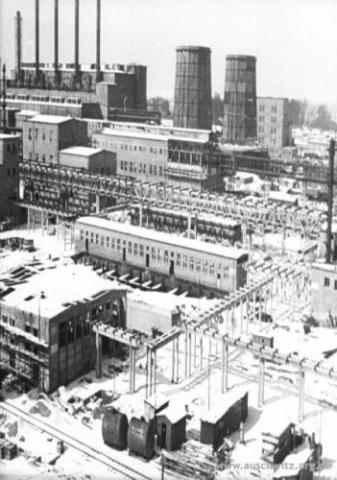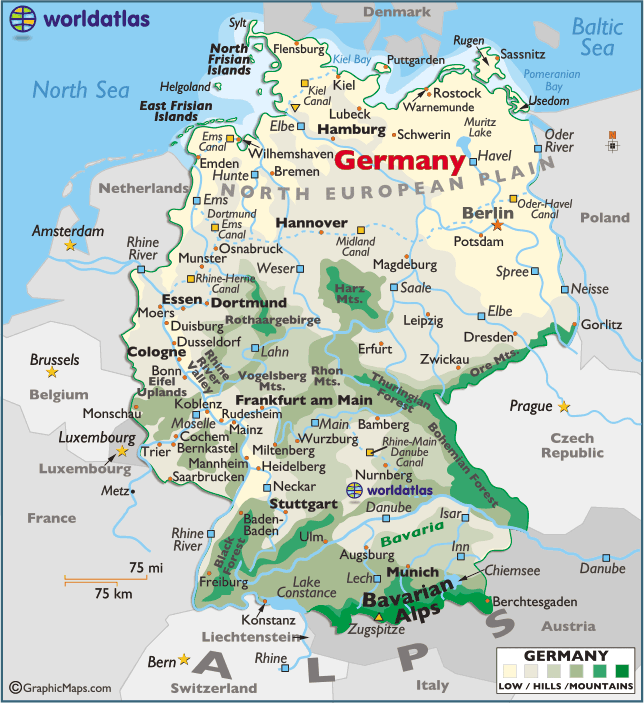Germany struggles to obtain needed raw materials for industry, handicrafts
From the Handbook for Schooling the Hitler Youth
Chapter Thirteen: The Soil as a Support for Industry (Handbook online is here)
The mountain ranges of central Germany contain most of the mineral deposits and other raw materials used for the industrial output of the nation.
The following has been lightly edited for greater brevity -cy
Just as the land gives man home and food, so also it supplies him the foundations of industrial life.
The distribution of minerals in Germany is to be explained in terms of their origin. Since they originate in part out of the interior of the earth, they can come to the surface only by breaking though the earths crust, as for example, by forming mountains. For this reason the presence of ores in Germany is confined primarily to the mountain ranges of central Germany. Even the minerals which originate from prehistoric, oceanic deposits are to be found mainly in central Germany, since these oceanic waters extended to the base of the mountain ranges.
The German land is blessed with numerous minerals and raw materials. The stone weapons and pottery, clothes and dwellings of the Norsemen show that even during the early stone age, wood and stone, wool, flax and clay were used as raw materials. Then the Germans made use of metals. They built mines and smelted the ores so obtained into bronze and iron. The handicrafts, which carried the work further, were held in high esteem by them. During the middle ages the handicrafts continued to develop. The entire economic life of this period was determined by the handicrafts. With the rise of natural science and technology, industry emerged out of the handicraft stage in consequence of the steady progress during this new period of economic life. With the same talents and capacities, German spirit and German work successfully asserted itself in the industrial age. The German worker, technician, and scientist made Germany the leading economic power of the world. About 19 million men are at work today in industry and the handicrafts fabricating German raw materials into consumer goods which are highly prized and in demand throughout the world.
The most significant German minerals are coal, salt, and ore. Petroleum is also found in some places.
The mining of hard coal goes on in six large districts:
-
in the Rhine-Westphalian coal region
-
the Saar basin
-
the Aachen basin
-
in the ore bearing mountain basin near Zwickau
-
the lower Silesian basin around Waldenburg,
-
in the upper Silesian basin
Deposits of soft coal lie principally in the central German regions of Halle, Leipzig and Kottbus, the west German region of Aachen, and the south German districts of Regensburg and Munich. [See map on p. 98 in online book here]
While the deposits of hard coal lie close to the frontiers and in case of war are especially endangered, the supplies of soft coal are in a more favorable location from the military point of view. Germany's stores of coal are sufficient for a long time. About 35 per cent of the European and 6 per cent of the world's supplies are in Germany. Consequently, Germany is the third largest exporter of coal in the world. The export trade absorbs a large part of the coal supply. Approximately 88 per cent of it is distributed to take care of German power needs. It is consumed not only in its raw state but also as gas, coke and benzine. In the coking process valuable by-products emerge which, like tar and ammonia, constitute one of the bases for our chemical industry. Coal is the most important factor in Germany's economic life.
The German deposits of calcium and rock salt are as significant as coal. They are found principally in the province of Saxony and in Anhalt. Our entire domestic needs can be covered from our resources and a large part devoted to the demands of the export trade. Rock salt is used primarily for technical purposes and to make soda. Table salt is procured from 46 salt works scattered throughout Germany. Calcium is turned over to the chemical industry which uses it mainly to manufacture fertiliser, a process from which important by-products emerge which are further utilised. Before the war [WWI], Germany was the only source of supply for calcium. By the dictate of Versailles the Alsatian deposits fell to France, making a part of the foreign market competitive for us today.
The German ore deposits occupy third place. They are:
Iron and manganese in Siegerland, the Lahn-Dill district near Vögelsberg in southern Bavaria, near Saizgitter, and more recently in the Weser mountains, in upper Franconia and in the Riesengebirge.
Sulfer deposits are in Weggen on the Lenne.
Lead is mined in upper Silesia, along the lower course of the Lahn, near Köln and Aachen, zinc in the northern Harz mountains, and nickel in Saxon Oberlausitz and near Frankenstein in Silesia.
The supplies of all these ores do not by any means meet the German requirements. Ninety percent of the iron and copper requirement must be imported, while almost all the remaining ores come from abroad. A fourth of Germany's sulfur requirement are taken care of at home.
Gold and silver are also obtained in very small quantities in Germany; gold from the arsenic deposits of Reichenstein in Silesia, silver as a by-product in the copper mines of Mansfeld. By far the largest part of these precious metals is, however, imported.
Finally, consideration must be given to Germany's supply of petroleum. The largest centers operating at present are in Hannover and Thüringia. They provide, however, only 10% of requirements. New sources are now being tapped in Rhinegraden, along the Tegernsee and near Passau. Germany suffered irretrievable loss by having Alsace taken away, since the most productive German supplies were found there in the oil fields of Pechelbronn.
So far as plant and animal raw stuffs (flax, hemp, wool and skins) are concerned, Germany has no domestic production worthy of the name, in consequence of neglect in this sphere. Attempts are now being made to increase the production of these raw materials also, although agricultural land must be used primarily to ensure German independence in food. The textile and leather industries, which make use of these raw materials, are therefore in large part dependent upon imports. Even wood must be imported, since it is used so extensively that the large forests of Germany could only supply sufficient quantities by irresponsible robbing of the woodlands.
If one compares the domestic supply of raw materials with the use in industry and the handicrafts in 1935, one obtains the following picture of imports and exports:
Exports
hard coal, coke ….. 279.0 million Reichsmarks
salt and calcium … 52.6
nitrogen fertiliser 43.1
total.............. 374.7
Imports
textile raw materials (fiber and yarn) 849.2 million Reichsmarks
ores and metals 450.9
wood and cellulose 226.0
hides, leather, felt 185.6
mineral oils (benzine) 178.1
india-rubber 45.5
mineral phosphates 35.0
other raw materials 259.2
total: 2,230.2
These figures indicate that Germany must import about 45 per cent of the raw materials used in German industry. Foreign countries can at any time exercise an economic pressure on Germany. To this end, Germany was quite consciously forced into its present raw material situation in that she was deprived of important sources of raw materials by having territory taken away and being robbed of colonies in the Versaillies treaty.
By reason of the loss of Alsace-Lorraine and Upper Silesia the Reich lost:
-
80 per cent of her iron supplies
-
70 per cent of her zinc deposits
-
64 per cent of her Thomas meal production
-
41 percent of her lead supplies
-
26 per cent of her hard coal supplies
-
26 per cent of her calcium production
-
10 per cent of her standing timber
-
10 per cent of her wool production
-
and important petroleum resources.
So it is evident that Germany could save many million Reichsmarks, which must now be used to pay the cost of importing raw materials, if she had not been deprived of her best ore pits. The perpetrators of the Versailles dictate have not been satisfied with this theft. In addition they have taken away Germany's colonies from her, and thereby barred access to all tropical and colonial raw stuffs. In the African possessions alone Germany was deprived of:
-
52,400 hectares of rubber plants
-
13,000 hectares of cotton plants
-
554,000 head of sheep
-
722,000 head of cattle and goats.
Moreover, in our former colonies there are supplies of gold, diamonds, tin, copper, lead and mineral phosphates which can cover a good part of our present imports of these raw materials. When the colonies were stolen from Germany, they were just at the beginning of their development. The mandate powers today possess enormous colonial empires and yet by no means make a productive use of them This is partly on purpose since they appear only as competitors of their older colonies. Germany could, by more intensive cultivation, obtain greater results from our former colonies than the mandate powers do today. To obviate our scarcity of raw materials, the return of our former colonies is absolutely necessary. The Leader has emphasized again and again that Germany as a great industrial country can never renounce its colonies.
Germany would gladly buy from abroad the raw materials which we lack, if a sufficient possibility were given for doing so. Foreign countries, however, demand payment in foreign currency, which we can only obtain by exporting German goods. Those countries with raw materials shut out German imports and play in part the Jewish boycott game. Our exports have shrunk, therefore, in exactly the ration that the National Socialist economic revival has increased our need for raw materials.
Our need for raw materials, and the possibility of importing them, develops along exactly opposite lines. For that reason the German economy - industry and handicrafts - finds itself in very serious difficulties. To put German workers back to work again and raise the production of goods to the point of doing away with German poverty, extraordinary measures are necessary. The Leader has, for this reason, announced the Four Year Plan, which is to free the Reich from the necessity of importing raw materials.
The Four Year Plan
The most pressing task of the Four Year Plan is to assure a sufficient domestic production of textiles. Textile raw materials are the heaviest burden on our foreign tirade, and the largest number of workers, proportionately, work in the textile and related industries. In 1933 every sixth person was at work in the textile business. The technical and scientific preparations for building up a domestic foundation of textile raw materials have already been in process longer and have gone the farthest. Here the Four Year Plan will be able to show the quickest and most positive results. Even now artificial silk can be produced in unlimited quantities out of German wood. By obtaining cell-wood from short fibred leaf woods it is possible for us to reduced enormously the importation of textile raw materials, especially wood and cotton. During the coming years an even greater progress in this field is to be expected. The hard fibres, too, like jute, hemp, and so on, can now be supplied to a certain extent by the use of wood products. Even if wood must be in large part imported, the amount of money used for this purpose is actually far less than that needed for importing textile raw materials themselves. In case attempts should succeed (such as those on the Rhine and in the Taunus lead one to hope) to adapt to our climate a fibre plant, the Yucca, coming from Central America, the independence of the German textile industry would be in sight. [See map of industrial regions on page 102 in online book here]
Ores and metals occupy second place on the list of imported raw materials. They make up about one fifth of all imports. The assurance of a necessary supply of ores and metals is especially important since they have a high significance in defence policy.
The most varied paths are being followed. German land is being searched for new ore deposits. Work is being done to find new methods of exploiting and smelting to make possible the utilisation of already known but poor ore deposits. Instead of heavy metals, light metals derived from aluminum and manganese are used wherever possible. Moreover, non-metallic materials are finding extensive use in place of metals. Finally, our domestic stores of metals are being kept intact by salvaging and using scrap metals and those that have been discarded.
Development of Buna
 The efforts to realise self-sufficiency in the case of rubber and mineral oils have progressed the farthest. We have been successful in producing from German coke and coal, a product superior to natural rubber: buna. This product can be dealt with and used exactly like natural rubber, and is superior to it in its ability to withstand chemicals, its reaction to oil and benzine, in its greater ability to stand up under heat and age, and its much greater wearing qualities. Since Buna is already being produced in large quantities and since, with the scope of the Four Year Plan, the production will be increased by extending the number of plants for Buna production about four-fold, every need which may arise in Germany will easily be taken care of. [Left: I.G. Farben industrial plant producing synthetic rubber and petroleum]
The efforts to realise self-sufficiency in the case of rubber and mineral oils have progressed the farthest. We have been successful in producing from German coke and coal, a product superior to natural rubber: buna. This product can be dealt with and used exactly like natural rubber, and is superior to it in its ability to withstand chemicals, its reaction to oil and benzine, in its greater ability to stand up under heat and age, and its much greater wearing qualities. Since Buna is already being produced in large quantities and since, with the scope of the Four Year Plan, the production will be increased by extending the number of plants for Buna production about four-fold, every need which may arise in Germany will easily be taken care of. [Left: I.G. Farben industrial plant producing synthetic rubber and petroleum]
German's domestic production of petroleum amounts to only 10% of her requirements. Even further successful borings, such as those being drilled everywhere in Germany, cannot within a conceivable time produce sufficient quantities. Nevertheless, the chemical industry has also succeeded here by processes of evaporation and carburisation in producing gasoline and oils out of our adequate supplies of existing raw materials such as hard coal, soft coal, oil shale, and wood. Tireless work is being done to better and cheapen these manufacturing processes in order that the production of gasoline and oils out of German raw materials will soon be an accomplished fact.
In the case of sponges, tanark, lampblack, sulfur, cork, paraffin, wax and so on, it has been possible to lower imports noticeably during the last few years. Further progress toward self-sufficiency and freedom from foreign countries is going on with the same zeal and fixed purpose. Great successes have already been realised. The Four Year Plan will continue to accelerate this succession of victories.
It must be obvious to every German comrade that if he supports these efforts by using Germany's own products, then the slogan will soon be fulfilled: German work out of German raw materials.~
This concludes the chapters from the Handbook for Schooling the Hitler Youth.
Listen to Carolyn talk about these last two chapters on "The Daily Nationalist" Wednesday: https://www.radioalbion.com/2019/11/the-daily-nationalist-self-sufficient.html
Category
Adolf Hitler, National Socialism, Schooling Hitler Youth- 798 reads










